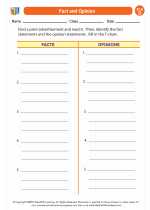Cause and Effect
Cause and effect is the relationship between two or more events where one event (the cause) makes another event happen (the effect). Understanding cause and effect helps readers comprehend how actions, events, or conditions lead to certain outcomes.
Examples:
- Cause: It rained all day. Effect: The ground became wet and muddy.
- Cause: The student studied hard. Effect: The student got a good grade on the test.
Fact and Opinion
Facts are statements that can be proven true or false. They are based on evidence and can be verified. On the other hand, opinions are personal beliefs or judgments that cannot be proven true or false. Distinguishing between fact and opinion is important for critical thinking and analyzing information.
Examples:
- Fact: The sun rises in the east and sets in the west.
- Opinion: Chocolate ice cream is the best flavor.
Study Guide
Here are some tips for understanding and identifying cause/effect and fact/opinion:
- When identifying cause and effect, look for keywords such as "because," "so," "therefore," "resulted in," or "led to."
- Use evidence and logical reasoning to determine if a statement is a fact or an opinion. Facts can be proven with evidence, while opinions are based on personal preferences or beliefs.
- Practice identifying cause/effect relationships and distinguishing between facts and opinions by reading short passages and discussing the relationships and types of statements with a partner or in a group.
- When writing, be mindful of using clear cause/effect relationships and supporting facts rather than opinions to strengthen your arguments or explanations.
By understanding cause and effect relationships and being able to differentiate between facts and opinions, students can enhance their reading comprehension, critical thinking, and communication skills.
[Cause/Effect, Fact/Opinion] Related Worksheets and Study Guides:
.◂English Language Arts Worksheets and Study Guides Fourth Grade. Cause/Effect, Fact/Opinion

 Activity Lesson
Activity Lesson
 Worksheet/Answer key
Worksheet/Answer key
 Worksheet/Answer key
Worksheet/Answer key
 Worksheet/Answer key
Worksheet/Answer key
 Worksheet/Answer key
Worksheet/Answer key
 Worksheet/Answer key
Worksheet/Answer key
 Worksheet/Answer key
Worksheet/Answer key
 Worksheet/Answer key
Worksheet/Answer key
 Worksheet/Answer key
Worksheet/Answer key
